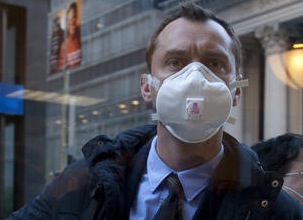 When I hear the word IMAX, my brain immediately conjures up images of two things: mind-blowing nature documentaries (oooo, look at all the jellyfish!) and The Dark Knight. They’re both about scope, taking full advantage of the IMAX screen’s expansive plane by filling it with panoramic spectacles. There’s a reason Michael Bay followed closely on the coattails of Christopher Nolan’s blockbuster experiment with his own Transformers: Dark of the Moon—IMAX makes big action bigger, loud action louder and explosive action…explosivier.
When I hear the word IMAX, my brain immediately conjures up images of two things: mind-blowing nature documentaries (oooo, look at all the jellyfish!) and The Dark Knight. They’re both about scope, taking full advantage of the IMAX screen’s expansive plane by filling it with panoramic spectacles. There’s a reason Michael Bay followed closely on the coattails of Christopher Nolan’s blockbuster experiment with his own Transformers: Dark of the Moon—IMAX makes big action bigger, loud action louder and explosive action…explosivier.
This weekend sees the release of Contagion, a movie that exists on the other end of the cinematic spectrum from movies with fighting robots or caped crusaders. The film, directed by Steven Soderbergh (Ocean’s 11, The Informant!), is a chilling, character-driven thriller, tackling the large-scale terror of a global epidemic with a few small through-lines. Contagion is an intimate tale, claustrophobically so—which makes its upcoming IMAX unexpected and curious.
Yes, Contagion follows in the footsteps of 2011’s big summer movies like Transformers 3, Harry Potter and the Deathly Hallows – Part 2 and Cars 2 to make the jump to the BIG, big screen. But a Roland Emmerich-style “oh no the whole world’s being destroyed by viruses!” movie this is not. Instead we follow A-list actors like Matt Damon, Kate Winslet, Jude Law and Marion Cotillard as they navigate the chaos in the wake of a deadly, new disease (and with all the gravitas you’d come to expect from those names). There are no sweeping shots of thousands of people running for their lives, nor a look into the post-apocalyptic, disease-stricken future. Just a couple of folks trying to make sure humanity doesn’t see itself completely wiped out.
 Not exactly IMAX material? Perhaps. But what you realize after witnessing Contagion play out across the breadth of an enormous screen is that the assumption that IMAX is only for major blockbusters is pigeonholing a great technology. Much like 3-D, IMAX has the ability to artistically change the way a movie is digested, ingraining itself in the filmmaking nuances to help tell a film’s narrative. In the case of Contagion, it makes the movie a thousand times more terrifying.
Not exactly IMAX material? Perhaps. But what you realize after witnessing Contagion play out across the breadth of an enormous screen is that the assumption that IMAX is only for major blockbusters is pigeonholing a great technology. Much like 3-D, IMAX has the ability to artistically change the way a movie is digested, ingraining itself in the filmmaking nuances to help tell a film’s narrative. In the case of Contagion, it makes the movie a thousand times more terrifying.
Soderbergh understands the haunting power of a dirty door handle, a messy apron or a slimy subway pole. Every germ-carrying entity on the planet is shot up close and personal, the camera lingering on moments that force us to comprehend that, yes, everything we touch can (and will) lead to our imminent death. A human face will never seem more disgusting than after one viewing of this film.
And that’s where the IMAX comes in. Contagion already acts like a microscope to our virus-infested world, but IMAX cranks up the magnification. In the back of a normal theater, you’d see a handshake and realize what Soderbergh’s trying to do. In the IMAX version, you feel the handshake, practically watching the virus unknowingly pass between victims. The physical distance from you and an object in a movie has decreased and you can’t escape it.
Contagion proving itself on the IMAX screen opened my mind to the possibilities of the format. While I’ve seen plenty of up-rezzed summer movies, they just feel like…bigger summer movies. For me, the only thing a movie like Fast Five gained from IMAX was bigger cars—not exactly worth the extra cash. But in Contagion, the oversized imagery adds something to the story and the terror of the situation. The movie goes from slick thriller to straight-up horror movie by putting you face-to-face with the enemy—which in this case, are infectious microbes that feel the size of IMAX pixels. Gross.
Mission accomplished.


